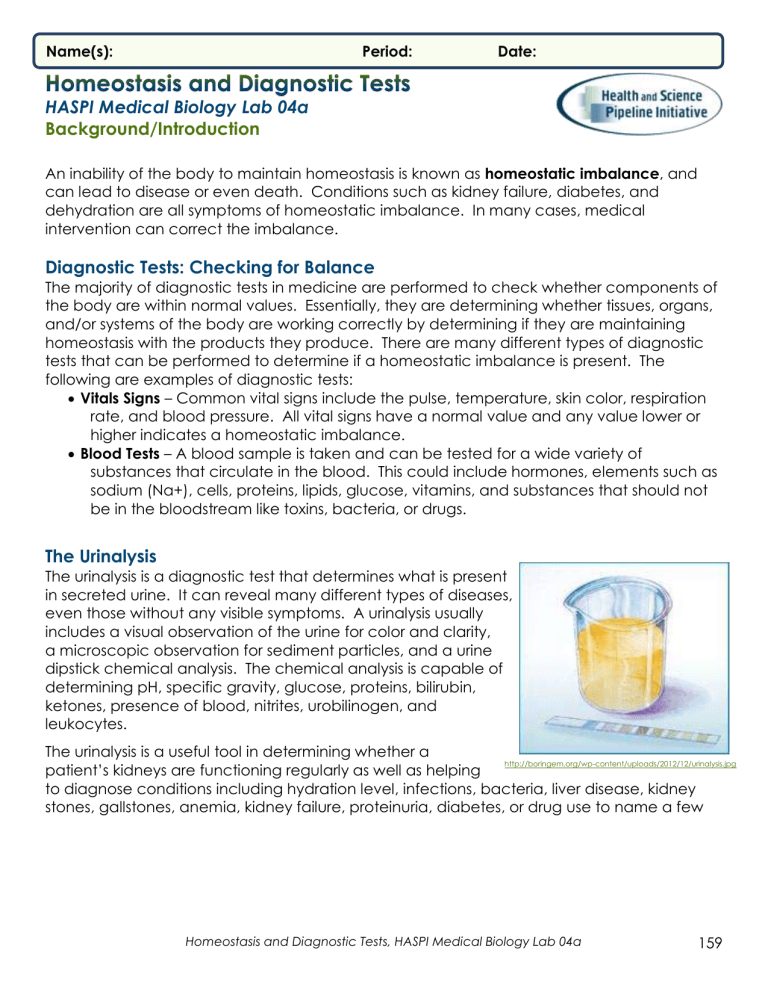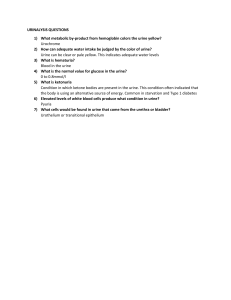
Name(s): Period: Date: HASPI Medical Biology Lab 04a Background/Introduction An inability of the body to maintain homeostasis is known as homeostatic imbalance, and can lead to disease or even death. Conditions such as kidney failure, diabetes, and dehydration are all symptoms of homeostatic imbalance. In many cases, medical intervention can correct the imbalance. Diagnostic Tests: Checking for Balance The majority of diagnostic tests in medicine are performed to check whether components of the body are within normal values. Essentially, they are determining whether tissues, organs, and/or systems of the body are working correctly by determining if they are maintaining homeostasis with the products they produce. There are many different types of diagnostic tests that can be performed to determine if a homeostatic imbalance is present. The following are examples of diagnostic tests: Vitals Signs – Common vital signs include the pulse, temperature, skin color, respiration rate, and blood pressure. All vital signs have a normal value and any value lower or higher indicates a homeostatic imbalance. Blood Tests – A blood sample is taken and can be tested for a wide variety of substances that circulate in the blood. This could include hormones, elements such as sodium (Na+), cells, proteins, lipids, glucose, vitamins, and substances that should not be in the bloodstream like toxins, bacteria, or drugs. The Urinalysis The urinalysis is a diagnostic test that determines what is present in secreted urine. It can reveal many different types of diseases, even those without any visible symptoms. A urinalysis usually includes a visual observation of the urine for color and clarity, a microscopic observation for sediment particles, and a urine dipstick chemical analysis. The chemical analysis is capable of determining pH, specific gravity, glucose, proteins, bilirubin, ketones, presence of blood, nitrites, urobilinogen, and leukocytes. The urinalysis is a useful tool in determining whether a http://boringem.org/wp-content/uploads/2012/12/urinalysis.jpg patient’s kidneys are functioning regularly as well as helping to diagnose conditions including hydration level, infections, bacteria, liver disease, kidney stones, gallstones, anemia, kidney failure, proteinuria, diabetes, or drug use to name a few Homeostasis and Diagnostic Tests, HASPI Medical Biology Lab 04a 159 Name(s): Period: Date: HASPI Medical Biology Lab 04a Scenario You are a medical laboratory technician at HASPI Hospital. There are 5 patient urine samples waiting for you to perform a urinalysis and to assist with a possible diagnosis. Each patient’s applicable medical history is listed below. Patient A: A 25-year-old male complains of feeling he “needs to go” all the time, but typically only produces a small volume of urine. The patient experiences a mild degree of discomfort during urination. He is also experiencing pain in his lower back. Patient B: A 28-year-old overweight male is experiencing excessive thirst (polydipsia), frequent urination (polyuria), increased appetite (polyphagia), and fatigue. He is also experiencing unexplained weight loss. Patient C: An 18-year-old healthy female provided a urine sample for a routine physical examination. She had difficulty producing even a small volume of urine. The physician noted that she had only a 12-ounce diet soda and some carrots to eat all day. Patient D: A 17-year-old female complains of joint pain and an unusual rash. She does not eat any red meat or poultry, and her only form of protein is fish – primarily tuna – which she eats daily. Patient E: An elderly female patient presents with abdominal pain following meals. The condition is more severe following a greasy meal. Materials 2 ml Patient A urine 2 ml Patient B urine 2 ml Patient C urine 2 ml Patient D urine 2 ml Patient E urine 5 Urine test strips 160 4 Test strip indicator sheets 9 Plastic pipettes Masking tape/pen 5 Test tubes Test tube holder Graduated cylinders Microscope Slide/coverslip Paper towels Scissors 4 Specimen cups 4 Ziploc bags Homeostasis and Diagnostic Tests, HASPI Medical Biology Lab 04a Name(s): Period: Date: Procedure/Directions Your lab team will be given tasks, or directions, to perform on the left. Record your questions, observations, or required response to each task on the right. Part A: Patient Urinalysis Task 1 2 3 4 5 6 7 8 9 Response Label each of your test tubes A, B, C, D, and E with the pen and small piece of masking tape. Place them in the test tube holder. a. Why do you think it is important to keep the There is a graduated cylinder next to each patient urine sample. Measure and pour 2 ml of graduated cylinders separate? each urine sample into the appropriately labeled test tube – DON’T MIX THE CYLINDERS! Using the scissors, cut the 5 urine test strips lengthwise. You should have 10 small strips. Five strips will be used for Part A and 4 for Part B. Return any extra strips to your instructor. The same results can be read on a full or half strip. a. Do you think food or drink choices could Observe each patient urine sample for color and clarity. Refer to the Background Section for drastically change the color of your urine? Explain your answer. reference. Record your observations in Data Table 1. Place a drop of “Patient A urine” onto the slide and place the cover slip over it. View the urine under the microscope to identify any sediment particles within the urine. If you see ANY sediment or crystals in the urine record a + in Data Table 1. If there are no visible particles record a – in Data Table 1. Clean off the slide and cover slip. Repeat step 5 for Patient Urine B-E. a. Do you think a single test parameter (color, Place one of the urine test strips on a paper pH, etc.) that is imbalanced would make it towel. Use the plastic dropper for the urine easier to diagnose disease than multiple sample for Patient A to place urine on each of imbalances? Why? the 10 boxes on one strip. Each box requires 30120 seconds; the time needed for each test is on the urine test strip indicator sheet. Use the test strip indicator sheet to compare with your urine test strip. Record the value from the indicator sheet for each test in Data Table 1 in the analysis section. Repeat step 7 for the remaining four urine samples. Use Data Table 3 to determine which of the patient values are abnormal, and what those abnormal values may indicate as a diagnosis. Note: Physicians make diagnoses, but the work of lab technicians provides important information that the doctor often needs to do so. Homeostasis and Diagnostic Tests, HASPI Medical Biology Lab 04a 161 Name(s): Period: Date: Analysis & Interpretation Complete the following tables with data collected from your lab investigations. DATA TABLE 1: Patient Urinalysis Results Normal Color Yellow Clarity Clear Sediment Particles None Leukocytes None Nitrite None Urobilinogen None Protein None pH 6-7 Blood None Specific Gravity 1.0151.025 Ketone None Bilirubin None Glucose None 162 Patient A Patient B Patient C Patient D Homeostasis and Diagnostic Tests, HASPI Medical Biology Lab 04a Patient E Name(s): Period: Date: DATA TABLE 3: Abnormal Vs. Normal Urine Visual Observations Appearance Yellow and Clear Dark Yellow Brownish or Green Reddish-Amber Cloudy Milky Appearance Microscopic Observations Crystals Large Particles (casts) Property Leukocytes Nitrite Urobilinogen Protein pH Chemical Analysis Red Blood Cells (erythrocytes) Specific Gravity Ketones Bilirubin Glucose Possible Condition(s) Normal May indicate concentrated urine from dehydration May indicate bile pigments May indicate urobilinogen, which is produced in the intestine by bacteria in bile; evidence of liver disease, Addison’s, or other conditions May indicate phosphates, white blood cells (WBCs), bacteria, epithelial cells or fat May indicate presence of WBCs, bacteria, or fat Possible Conditions Can be normally occurring; persistent crystals may indicate kidney stones or infection May indicate chronic kidney failure, proteinuria, or be present after strenuous exercise Possible Conditions Indicates inflammation of the urinary tract usually caused by infection Normal urine has very little to no nitrite. Presence may indicate bacterial contamination/urinary tract infection (UTI) Urobilinogen is produced in the intestine by bacteria in bile; may indicate liver disease, Addison’s, or other conditions Normal urine has no protein. Presence may indicate kidney trauma, ingestion of heavy metals, bacterial toxins, nephritis, or hypertension; may also arise under conditions of physical stress or strenuous exercise Normal urine pH is between 6-7; below 6 may indicate gout, fever, or kidney stones; above 7 may indicate urinary tract infection, vegetarian diet, bowel obstruction, vomiting, or drug use May indicate irritation of the urinary tract organs by calculi or physical trauma; may also indicate hemolysis of red blood cells due to such conditions as anemia, transfusion reactions, burns, or renal disease Normal urine specific gravity is between 1.015 and 1.025 Less than 1.015: may indicate excess fluid intake, diabetes insipidis or chronic renal failure; More than 1.025: may indicate limited fluid intake, dehydration, fever, kidney inflammation Normal urine has no ketones. Presence may indicate starvation or abnormal metabolic processes such as excessive metabolism of fats or proteins in the body; possibly indicates diabetic ketosis Normal urine has no bilirubin. Presence may indicate liver pathology such as hepatitis or cirrhosis Normal urine has no glucose. Presence may result from excessive carbohydrate intake or diabetes mellitus DATA TABLE 4: Diagnosis and Treatment On a separate sheet of paper create a data table that summarizes the results, diagnosis, and possible treatments for patients A-E and your own results. Include the following in your table: Abnormal results (if there are none, write normal) Possible diagnosis (if any) Possible treatment options (you will need to research your diagnosis for this answer) Homeostasis and Diagnostic Tests, HASPI Medical Biology Lab 04a 163




